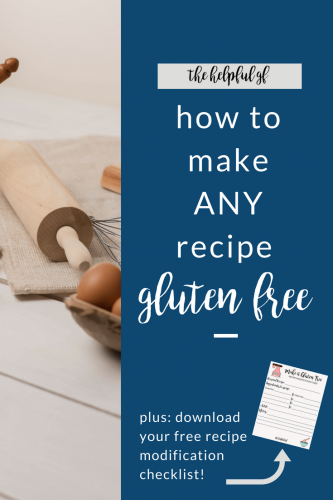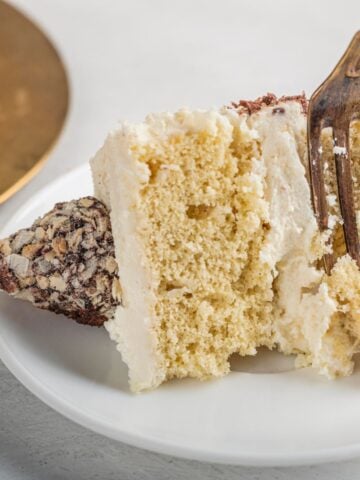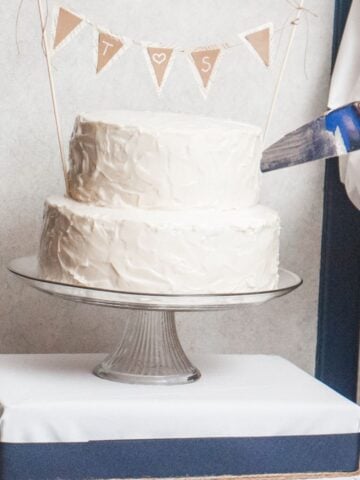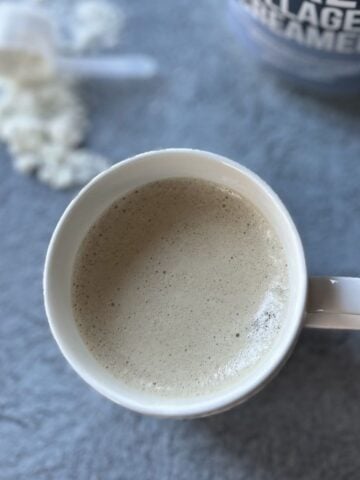When I first married my husband Tyler, who has Celiac, in 2012, I don’t think I realized how difficult cooking gluten-free would be for me. It wasn't until I realized how to modify and make any recipe gluten-free that it got easier.
Although I knew the logistics of gluten-free cooking back then (hello cross-contact and food labeling) and was comfortable in the kitchen, I also loved the comfort foods I grew up with.
And they were not naturally gluten-free.
The thought of “relearning how to cook” was so overwhelming!
As I searched gluten-free recipes in cookbooks and on Pinterest I suddenly I had a realization. I don’t need to reinvent the wheel—I can make any recipe gluten-free by just modifying the ingredients!
What started out as a super daunting process quickly became simple as I learned what ingredients work where!
While the recipe may not taste exactly the same when finished, you may even discover that the recipe may even taste better!
Keep on reading for 4 simple steps to make any recipe gluten-free, PLUS a free printable checklist to use when analyzing your favorite recipes!
This post contains affiliate links. If you order through one of these links I’ll earn a small commission at no extra cost to you! My full disclosure isn’t that interesting, but you can find it here.
Take this quick quiz and uncover the secrets to making your gluten-free lifestyle not just manageable, but truly enjoyable with custom recipes and tips!

1. Identify What Ingredients Need to Change
The first step to make any recipe gluten-free is to identify the ingredients that contain gluten. Beyond looking for the specific ingredients of wheat, barley, and rye, look in your recipe for the ingredients on this list as they likely contain gluten. While the ingredients on following marked with an asterisk* list do not always contain gluten, they often do—so check labels carefully!
- BBQ Sauce*
- Breading
- Broth*
- Couscous
- Farro
- Flour
- Graham
- Malt
- Marinade*
- Oats* (if using oats, make sure you are using oats processed under a purity protocol like Gluten Free Harvest Oats
)
- Pasta* & Orzo (check out my guide to the best GF orzo here)
- Salad dressing*
- Sauce*
- Semolina
- Soy Sauce/Teriyaki
- Spelt
- Stuffing
- Tabouli
Beginner tip: start with recipes that only need 1-2 minor ingredient swaps!
2. Find Your Substitutions
I have a whole post dedicated to gluten-free substitutions in this ultimate guide.
For most recipes, you can find an EXTREMELY similar (if not identical) substitution. Just make sure you read labels to be sure that your ingredients are gluten-free. If it’s not a whole food ingredient, I like to look for products labeled “certified gluten-free.” Below are common substitutes when trying to make any recipe gluten-free.
Learn more about gluten-free certification and labeling in this post!
- pasta: there are SO many kinds of gluten-free pastas, but it may take some experimenting to find one that you love. My personal favorites are gluten-free pastas with a combination of ingredients (corn, rice, quinoa) such as Barilla and Aldi’s. I also prefer shorter pasta shapes (such as penne or macaroni) over long strands like spaghetti or fettuccine. In my personal experience, the long strands tend to stick together really terribly and I have a difficult time getting it to cook evenly.
- condiments: Worchester sauce, soy sauce, vegetable oil, and other condiments may contain gluten! These are super easy swaps—just make sure to read labels and ONLY purchase gluten-free versions.
- special note about soy sauce: there have been cases over the past few years of companies & restaurants getting into trouble with the FDA for incorrect labeling of soy sauce. To keep it safe, look for Tamari or Soy/Coconut Aminos clearly labeled gluten-free.
- Also--read my full break down of soy sauce and what to use instead here.
- special note about soy sauce: there have been cases over the past few years of companies & restaurants getting into trouble with the FDA for incorrect labeling of soy sauce. To keep it safe, look for Tamari or Soy/Coconut Aminos clearly labeled gluten-free.
- bread crumbs: Probably the yummiest solution is to make your own from your favorite gluten-free bread, however there are countless other gluten-free substitutions for bread crumbs! Some stores sell gluten-free bread crumbs. One option is to grind gluten-free cereal, gluten-free crackers, or gluten-free chips in a food processor until desired consistency. Sometimes you can even sub grated Parmesan cheese or a coarser ground almond flour. It really depends on the recipe and the desired outcome.
- flour: If your recipe calls for flour for dredging, I recommend using a basic gluten-free all-purpose flour. If it calls for flour for thickening (i.e. gravy or a roux) you can sub corn starch or arrowroot powder.
I buy a lot of my gluten-free specialty ingredients from Thrive Market. Click here to read my post about Thrive Market PLUS get a free trial month and up to $20 off your first order.
3. Special tips for Baking
In addition to the above 2 tips, baking requires its own bonus section. Baking really is a science, and mastering gluten-free baking is like graduating with a PhD.
If new to gluten-free cooking (or if you just aren’t that adventurous—like me) I HIGHLY recommend that you stick with gluten-free box mixes for baking.
These companies have experimented, taste tested, and mixed flours like crazy to get them to come out right. I’ve even tried a bunch out and written reviews throughout my blog.
If you’re curious about gluten-free cake mixes, you can read my cake mix reviews here.
But if you just have a sweet spot for baking from scratch or have some amazing family recipes you just can’t spend the rest of your life without, here are my special tips for how you can make any recipe gluten-free when baking.
Choose the right flour (or flour blend).
Not all gluten-free flours are equal—nor do they behave like regular all-purpose or wheat flour when baking. Mimicking an all-purpose flour requires mixing all kinds of different flours together to make any recipe gluten-free.
The best recipe for all-purpose gluten-free flour I’ve tried is the on in the How Can it Be Gluten-Free Cookbook by America’s Test Kitchen.
However, mixing your own flour blend is time consuming, not to mention being fairly expensive up front due to buying such a wide variety of specialty flours.
Therefore, I recommend beginning with a good quality all-purpose cup-for-cup gluten-free flour blend like King Arthur.
Measure by weight instead of volume.
Instead of measuring your gluten-free all-purpose flour in a measuring cup, weight it on a food scale for more precise baking. One cup of all-purpose flour equals approximately 125 grams.
Add additional ingredients to improve the texture.
Even when using a premixed gluten-free all-purpose flour, you might still need to add special ingredients to get the composition of the batter or dough correct.
Try adding a teaspoon of xanthan gum to thicken or help the dough hold together. Add an egg to help ingredients bind if it seems too dry.
Is the mix too wet? Add some more flour. Is it super sticky? That’s probably normal—haha!
Tip for working with super sticky dough—if it’s too sticky to work with you have a few options: a. wet your hands before mixing or patting down (this will keep the dough from sticking to your hands), b. spray plastic wrap with a gluten-free cooking spray and work with the dough underneath the plastic wrap (this is great if you’re working with pizza crust), or c. refrigerate the dough!
Let the batter sit for 15-30 minutes BEFORE putting it in the oven.
GF flours are often coarse, letting it sit allows the flours to absorb the wet ingredients which will help eliminate grittiness.
4. Write Down Your Modifications
Make sure you write down what you tried for a substitution and review the finished product. Analyzing the recipe right after you eat it is a great way to keep experimenting.
For example, did you like gluten-free cornflakes for breading on chicken? Why or why not? If it was too crunchy, maybe you need to grind into finer crumbs.
If it was too sweet, next time try kettle chips or tortilla chips.
Reviewing what worked, and what didn’t, will set you up for greater success modifying recipes in the future.
What's they key to loving your gluten free life? Get your personalized plan with the guide you need to thrive!


Do you have any tips on how to make any recipe gluten-free? Share them in the comments below!
PS--If you enjoyed this post on How to make any recipe gluten-free, share it with your friends on social media and pin it for later!





Kate
This is a great overview - so much helpful info. I wish I'd had found something like this post back in 2010 when I was diagnosed with celiac - it would have been SO HELPFUL! I've shared this on my Facebook and Pinterest accounts. Thanks for writing it.
thehelpfulgf
I know! Back in 2012 I felt like I had to abandon what I was used to making. It wasn't until a few years later (and struggling through learning all new recipes) that I realized how easy many things are to substitute. Thanks for the shares!
Nicole
This was super helpful, thanks! Cutting out allergens in baking recipes is the toughest one for me. The texture is sometimes so far off I can't even stomach my end results. I'm going to try your let the dough sit top, I'm excited to see how my muffins turn out with the modification!
thehelpfulgf
I hope it helps Nicole! I've seen a bit of a difference in my baking after doing that. However, I often found that baking is just too dang hard to replicate and stick with using mixes! (but even in a mix, I often still add that extra egg and let it sit!)
Dee
Helpful blog post! Thanks for sharing!
Joanne
This is such a great post! My daughter has nut allergies, as do many in school, so those are always taken care of during parties and get togethers. It's awesome to have a list of substitutes and baking instructions to help make party foods that are safe for everyone!
Evelyn
This is great as there are so many people that are gluten free and avoid many recipes because of this reason.
Jenn
This is some great advice. The gluten free industry has come so far in the last few years.
JOHN MULINDI
Always great to learn some new recipes. Thanks very much for sharing.
Alexine
This is great! finally, I have learned a lot how to create recipes with gluten free products. I think I have memorize them all, since I have a friend who's allergic of gluten I can share this with her.
jenny bhatia
Very helpful post. WE are not gluten free, but have multiple food allergies. I know how it is reading labels and never assuming. It can be daunting. These tips and your website are so good for people facing this issue. You make it ok!
thehelpfulgf
thank you!
Rachel
Loved the tips about cooking with gluten free flours. Also, the substitution recommendation list is very helpful.
thehelpfulgf
So happy this is helpful to you!
Isabella Ava
Hello,
I am a big fan of your gluten-free recipes. Tried some of them at my home and my husband loves them a lot though he is not a big loved of gluten-free foods.
Anyways, I have a question. Yesterday I went to a grocery shop near to my house. And noticed a product labeled as Non-Gluten. Is there any difference between non gluten and gluten-free products?
I googled and find this article about Non-gluten (https://japanesericeflour.com/What%20is%20Non%20Gluten/), I don’t know whether it is correct or not.
Thanks.
Isabella.
Sharon McCaskill
GREAT question Isabella! Are you in the US? If so, there is only regulation over the term 'gluten free' by the FDA, not other phrases like 'non gluten' or 'gluten friendly' or 'gluten lite' which some companies will use. These other phrases 'skirt around' the official and regulated labeling terms. I would assume this phrase means they don't use gluten containing ingredients. However, the only way to know for sure what this company means by this phrase is to contact them directly. Hope this helps!